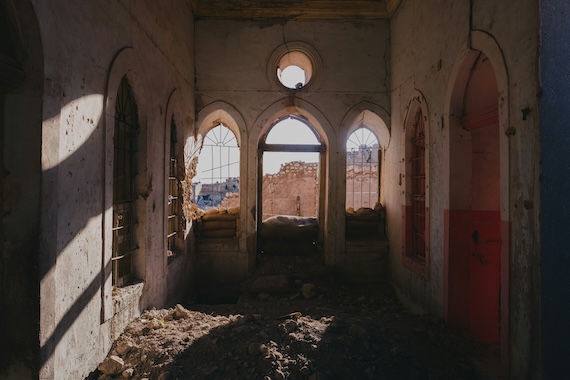( Rudaw.net) – A decade ago, on August 3, 2014, the Islamic State (ISIS) conquered the village of Kocho (Kojo) in the Sinjar (Shingal) area of northern Iraq. On August 15, it began massacring several hundred men and elderly women of the Yazidi community, an ethno-religious minority in Iraq and Syria, after they failed to convert to Islam. Nadia Murad, then 21 years old, witnessed the execution of her mother and brothers, and then was abducted along with other young Yazidi women as sex slaves.
Responsibility to Protect (R2P) is an international norm for states to prevent genocide, mass atrocities, and war crimes, in response to the failure to do so in the former Yugoslavia and Rwanda. The US airdropped food to trapped refugees on nearby Mount Sinjar, but sat on the sidelines as the massacre ensued in this village. Ten years later, the international community still has a Responsibility to Remember (R2R) to the Yazidis who died, to those dealing with post-traumatic stress disorder (PTSD), to the more than 2,000 who are still missing, and to the other victims of war who are only increasing in number in the 21st century – from the north of Iraq to Ukraine to Gaza. The United Nations Investigative Team to Promote Accountability for Crimes Committed by Da’esh/ISIL (UNITAD) was a dedicated R2R body. Yet, its mandate will soon be terminated.
Murad was able to escape and arrived in Germany in 2015. She was one of the fortunate also appointed as a UN goodwill ambassador, the first to represent “Dignity of Survivors of Human Trafficking.” Murad was eventually awarded the Nobel Peace Prize, the first Iraqi to ever receive it.
In 2016 she met the Beirut-born British barrister Amal Alamuddin Clooney, who agreed to represent Murad. Both addressed the United Nations, advocating that the ISIS campaign be designated as a genocide. Their work was essential to the Security Council agreeing to establish UNITAD in 2017.
Photo by Levi Meir Clancy on Unsplash
In the lobby of the United Nations General Assembly, a replica of Picasso’s Guernica mural hangs above the podium where international figures field questions from the media, a form of R2R for the multilateral body, as the failure of the world community to act after Guernica eventually led to World War Two. By bearing witness to Guernica, UN diplomats would work to ensure it would not happen again. Yet, Guernica did happen again: in Halabja at the end of the 20th century, and Kocho was the Guernica of the 21st century.
UNITAD was an attempt to prevent future Guernicas. The Iraqi judicial system lacked the infrastructure to investigate and try all the members of ISIS responsible for these crimes; hence, Baghdad requested the aid of the UN in the form of UNITAD, which has been collecting evidence since 2017.
Yet, the Iraqi government sought to terminate this body’s mandate in 2024 due to conflicts with the UN team investigating the crimes. This denies justice to the survivors of ISIS atrocities. Closing such a body is not only a loss for the female survivors of gender-based violence, the Yazidis, as well as the Iraqi nation in general, it sets a tragic global precedent; a dedicated UN body is imperative to document genocidal and gendercidal violence, and victims of war.
The genocidal rampage that ensued in Kocho in August 2014 continued for the women in captivity. To forge homogeneity within their “Islamic” state, ISIS sought the erasure of a pre-Islamic past by destroying pre-Islamic antiquities and what it deemed as “pre-Islamic peoples,” expelling Christians from Mosul, or enslaving Yazidi women to ensure that they could not give birth to future Yazidi children, a form of genocide specifically targeted against one gender, in what can be more specifically called a gendercide. Their captivity not only led to their estrangement from other Yazidis, but any future children born out of this slavery would not be considered part of the endogenous community.
The work of lawyers or human rights investigators is like a historian, trying to collect material from the past from primary sources to construct a narrative in the present. Primary sources, in this case, include the videos and documents produced by ISIS itself documenting their genocide, as well as the testimonies of the victims.
R2R is a reminder, as well, to the damage done to the spiritual heritage of Yazidi temples and Christian churches by ISIS, in addition to forced expulsion. Both physical reconstruction and investment in mental healthcare infrastructure, which Iraq lacks, are still needed.
UNITAD sought to deliver justice. It is a body that needs to be replicated for those who suffer due to decisions made by terrorists, warlords or politicians who will never be held accountable for their actions all the way from Kocho to the fighting in Ukraine and Gaza.
As a historian, these deaths and victims inspired me to advocate for R2R for the victims of war. Life is one episode in this greater history of soldiers and civilians from the north of Iraq and Syria under ISIS, to Ukraine to Gaza, who have died or endured trauma and PTSD, internally displaced peoples and refugees, child soldiers, the victims of gender-based violence during conflict, the kidnapped and tortured, those maimed by landmines or IEDs and amputees, many reliant on prosthetics, landscapes poisoned by depleted uranium, to animals and domesticated pets caught up in conflicts that they had no role in creating.
Reprinted with the author’s permission from Rudaw.net



 © 2025 All Rights Reserved
© 2025 All Rights Reserved